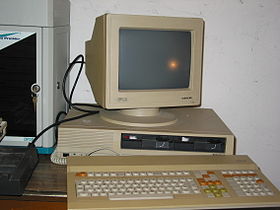Siemens PC-D
| Siemens PC-D | |
|---|---|

|
|
| Manufacturer | Siemens |
| Type | Personal computer |
| publication | 1982 (as PC-X) 1984 (as PC-D) |
| End of production | 1986 |
| processor | Intel 80186 processor with 8 MHz |
| random access memory | 128 KB to a maximum of 1 MB |
| graphic | Proprietary, 640 × 350 pixels monochrome |
| Sound | PC speaker |
| Disk | 5-1 / 4 ″ disks with the 360 KB IBM format (40 tracks) and 720 KB (80 tracks). |
| operating system |
Sinix (in the PC-X) MS-DOS 2.11, finally also 3.20 (in the PC-D) |
| successor | Siemens PCD-2 |
The PC-D or PC-X is a personal computer that Siemens sold from 1982 (PC-X) and 1984 (PC-D) to 1986. The PC-D was the first MS-DOS PC from Siemens AG, but was only partially compatible with IBM PCs .
The PC-D line was given up in favor of the production of the PCD-2 .
Difference between Siemens PC-D and Siemens PC-X
The Siemens PC-D and PC-X are basically identical. The PC-D was designed more for private users and was the first Siemens PC to be delivered with MS-DOS (2.11, most recently also 3.20), while the PC-X, on the other hand, came with Sinix , Siemens' own Unix derivative . The PC-X was therefore tailored to more professional applications. It also received 1 MB of RAM, a hard drive and an MMU as standard .
Features and differences to the IBM PC architecture
The PC-D or PC-X works with an Intel 80186 processor with 8 MHz and has 128 KB to a maximum of 1 MB RAM. The basic version only had a floppy disk drive; a second floppy disk drive or a hard disk with 13 or 20 MB were optionally available. The computer is partially compatible with the IBM PC . The most noticeable differences are:
- The Intel 80186 processor.
- The 5 1 ⁄ 4 ″ floppy disk drive supports the 360 KB IBM format (40 tracks) as well as the 720 KB (80 tracks) format, which is unusual in the PC sector.
- Graphics display with 640 × 350 × 1 bit: The graphics card is incompatible with common PC standards ( MDA , Hercules , CGA etc.). It is also noticeable that the monitor is powered by the graphics card.
- Serial interfaces according to the V.11 standard for keyboard and mouse.
- For printers there are interfaces according to both the V.11 and the V.24 standard otherwise common in the PC area ; however, a parallel interface was only available as an accessory. Without this, the serial interfaces were addressed with LPT1 and LPT2.
- The keyboard has a built-in speaker.
- Different keyboard layout: Among other things, there is a separate help key and keys for printer control, while only five keys (← ↓ ↑ → and Home) are available for cursor control.
- Incompatible bus system ( VG96 Local Bus ).
- The on / off switch can be blocked by software.
- There is a debug button that can be used to display the processor register values.
- The SCSI interface on the motherboard . The hard disks with 13 or 20 MB offered by Siemens were not connected directly. Instead, hard disks with an ST506 interface with a separate controller board were used.
equipment
Siemens sold various accessories for the PC-D / PC-X. These included u. a. a Centronics interface , a mouse and the PT88 / 89 needle and inkjet printer in A4 or A3 format with nine needles or nozzles and a serial interface.
The software offer for the PC-D was comparatively manageable. But there was, among other things, MS-DOS up to version 3.20, Microsoft Word , Microsoft Multiplan , Microsoft Chart , dBase II , a GW-BASIC interpreter and compiler and even Microsoft Windows (1.02). There was also a collection of comparatively simple games. A patched version of the Microsoft Flight Simulator was a treasure . Most of the DOS applications for the IBM PC could not run on the PC-D without modification. Most Windows applications, however, could be exchanged between the two systems. The reason for this was that DOS or Windows system calls were supported on the PC-D with DOS / Windows, but not the lower level / hardware system calls (often used by DOS programs). If an application used these lower level calls, it had to be patched (e.g. with the debugger) and / or recompiled if necessary in order to run on the Siemens PC-D hardware, which is not 100% IBM-compatible. In return, applications patched in this way could normally no longer run on normal IBM compatible machines.
literature
- Dietmar Eirich: The Siemens PC-D practice book , Munich 1986, ISBN 3-924767-13-0